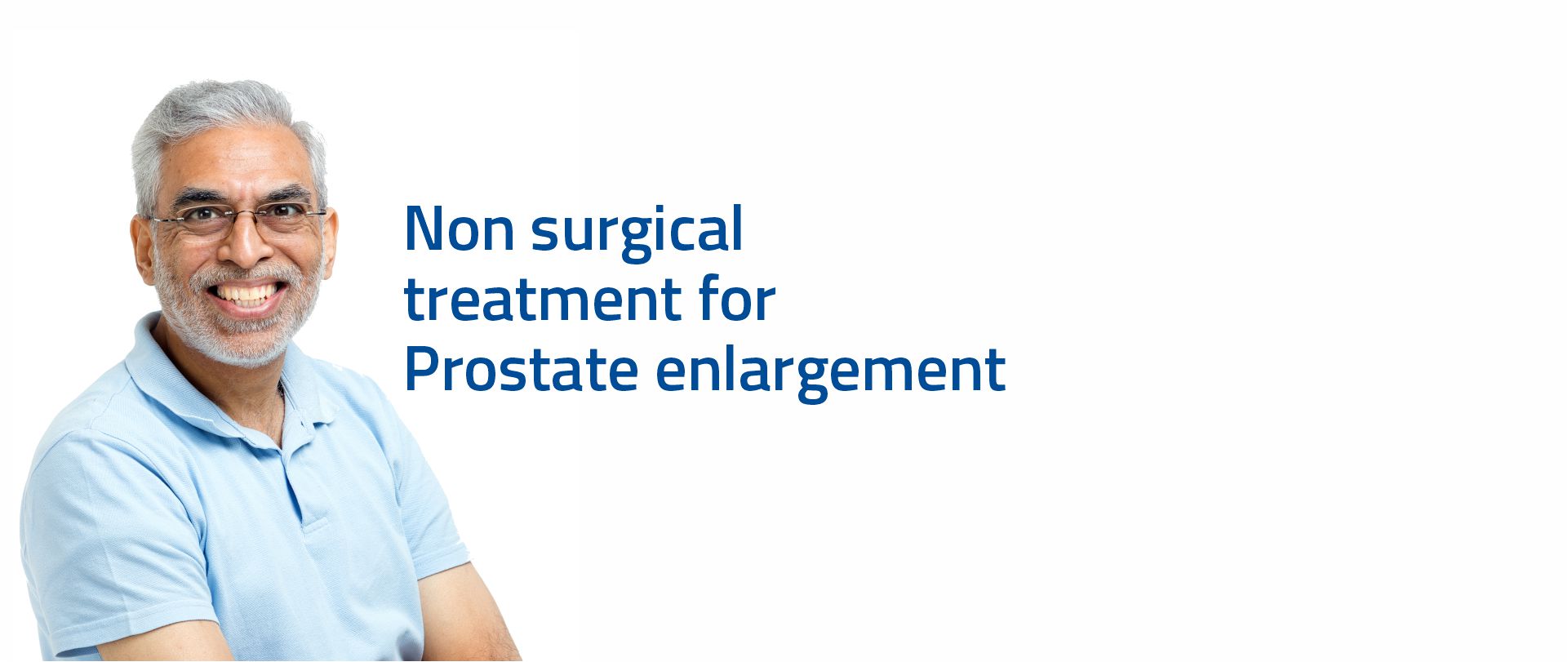What is UroLift?
UroLift is a minimally invasive procedure used to treat lower urinary tract symptoms (LUTS) caused by an enlarged prostate, a condition known as benign prostatic hyperplasia (BPH). It offers an alternative to traditional surgical treatments like transurethral resection of the prostate (TURP) or laser ablation techniques. The UroLift system involves the use of small implants to hold the obstructing prostate lobes away from the urethra, thereby relieving urinary symptoms.
Here's a general overview of the UroLift procedure:
- Anesthesia: UroLift is typically performed under local anesthesia. This means that only the surgical area is numbed, allowing the patient to remain awake during the procedure.
- Insertion of UroLift implants: The urologist inserts a cystoscope, a thin tube with a camera, through the urethra to access the prostate. Using the camera for guidance, small implants, consisting of a permanent suture and a tiny metallic tab, are placed into the prostate lobes. These implants hold the prostate tissue away from the urethra, widening the passage and improving urine flow.
- Completion of the procedure: Once the desired number of UroLift implants has been inserted, the cystoscope is removed, and the procedure is considered complete. No tissue is removed or ablated during the UroLift procedure.
Benefits of UroLift include:
- Minimally invasive: UroLift is considered a minimally invasive procedure since it does not involve cutting or removing prostate tissue. This typically results in less bleeding, reduced risk of complications, and a shorter recovery period compared to traditional surgical methods.
- Preserved sexual function: UroLift is associated with a lower risk of sexual side effects such as erectile dysfunction and retrograde ejaculation, which can be more common with other treatment options for BPH.
- Rapid symptom relief: Many patients experience rapid symptom relief after UroLift, with improvements in urinary flow and reduced LUTS within a few weeks.
- Outpatient procedure: UroLift is often performed on an outpatient basis, allowing patients to return home the same day as the procedure.
- Long-term effectiveness: UroLift has demonstrated long-term effectiveness in improving urinary symptoms and maintaining quality of life in patients with BPH.
Why and when is UroLift recommended?
UroLift is recommended as a treatment option for men who are experiencing lower urinary tract symptoms (LUTS) caused by benign prostatic hyperplasia (BPH), which is an enlarged prostate.
Here are some reasons why UroLift may be recommended:
- Minimally invasive option: UroLift is considered a minimally invasive procedure compared to traditional surgical treatments like transurethral resection of the prostate (TURP) or laser ablation techniques. It may be recommended for men who prefer a less invasive approach or those who are not suitable candidates for more invasive procedures due to underlying health conditions.
- Preservation of sexual function: UroLift has a lower risk of causing sexual side effects, such as erectile dysfunction or retrograde ejaculation, which can be more common with other treatment options for BPH. If preserving sexual function is a priority, UroLift may be recommended.
- Relieving urinary symptoms: The primary goal of UroLift is to relieve urinary symptoms associated with an enlarged prostate. These symptoms may include frequent urination, weak urine flow, difficulty starting or stopping urination, incomplete emptying of the bladder, or urinary urgency. If these symptoms significantly impact a man's quality of life or if medications alone are not effectively managing the symptoms, UroLift may be recommended.
- Outpatient procedure: UroLift is often performed on an outpatient basis, meaning the procedure can be done in a clinic or ambulatory surgical center, and patients can return home the same day. This can be beneficial for individuals who prefer not to stay in the hospital overnight or who want to minimize disruption to their daily routine.
- Smaller to moderate-sized prostate: UroLift is most effective for men with specific prostate characteristics, such as a prostate size of less than 80 grams and a certain shape and configuration. A thorough evaluation by a urologist or healthcare professional is necessary to determine if a patient's prostate anatomy is suitable for UroLift.
- Wish to avoid certain medications: Some individuals may prefer UroLift over long-term medication use for managing BPH symptoms. UroLift offers an alternative that addresses the underlying issue without relying on daily medications
How is UroLift different from the conventional treatment?
UroLift differs from conventional treatments for benign prostatic hyperplasia (BPH) in several ways. Here are some key differences:
- Minimally invasive approach: UroLift is a minimally invasive procedure that involves the use of small implants to hold the obstructing prostate lobes away from the urethra. In contrast, conventional treatments like transurethral resection of the prostate (TURP) or laser ablation techniques involve removing or ablating prostate tissue using surgical instruments or laser energy.
- Tissue preservation: UroLift is designed to preserve the prostate tissue while providing relief from urinary symptoms. The small implants hold the prostate lobes apart, widening the urinary channel and restoring urine flow. Conventional treatments involve removing or destroying prostate tissue to alleviate the obstruction.
- Local anesthesia and shorter hospital stay: UroLift can be performed under local anesthesia, which means that only the surgical area is numbed, allowing the patient to remain awake during the procedure. It is often done on an outpatient basis, meaning the patient can go home the same day. In contrast, conventional treatments may require general or spinal anesthesia, and patients may need to stay in the hospital for a day or longer.
- Sexual function preservation: One of the advantages of UroLift is its potential to preserve sexual function. Unlike conventional treatments, which can carry a higher risk of sexual side effects such as erectile dysfunction or retrograde ejaculation, UroLift is associated with a lower risk of these complications.
- Faster recovery time: UroLift typically has a shorter recovery time compared to conventional treatments. Patients may experience symptom relief within a few weeks after the procedure, with minimal downtime or restrictions on normal activities. Conventional treatments may involve a longer recovery period with potential limitations on physical exertion and sexual activity.
- Long-term effectiveness: UroLift has demonstrated long-term effectiveness in improving urinary symptoms and maintaining quality of life in patients with BPH. However, the long-term outcomes of UroLift may vary depending on individual factors and the progression of the condition. Conventional treatments also have established long-term effectiveness, but the specific technique used can influence outcomes.
How is life after UroLift?
Life after UroLift, a minimally invasive procedure for treating benign prostatic hyperplasia (BPH), can vary from person to person. However, here are some general considerations:
- Improved urinary symptoms: One of the primary goals of UroLift is to alleviate urinary symptoms associated with BPH. After the procedure, many patients experience relief from bothersome symptoms such as frequent urination, weak urine flow, difficulty starting or stopping urination, incomplete bladder emptying, and urinary urgency. Improved urinary symptoms can significantly enhance quality of life and daily activities.
- Rapid symptom relief: Unlike some other treatment options for BPH, which may require a longer recovery period, UroLift often provides rapid symptom relief. Many patients experience improvements in urinary flow and symptom relief within a few weeks after the procedure. However, the exact timeline of symptom improvement can vary.
- Preservation of sexual function: One of the advantages of UroLift is its potential to preserve sexual function. Unlike conventional treatments for BPH, such as transurethral resection of the prostate (TURP), UroLift is associated with a lower risk of sexual side effects such as erectile dysfunction or retrograde ejaculation. This can contribute to a better quality of life and sexual satisfaction after the procedure.
- Minimal downtime and recovery: UroLift is a minimally invasive procedure that typically requires minimal downtime. Most patients can resume their normal activities and return to work within a few days after the procedure. However, it's essential to follow the specific post-operative instructions provided by your healthcare provider to ensure proper healing and recovery.
- Potential for long-term effectiveness: UroLift has demonstrated long-term effectiveness in improving urinary symptoms and maintaining quality of life for many patients with BPH. However, individual experiences may vary, and some patients may require additional treatments or interventions in the future if their symptoms worsen over time.
- Follow-up care: After UroLift, regular follow-up appointments with your healthcare provider will be necessary to monitor your progress, evaluate the effectiveness of the procedure, and address any concerns or complications that may arise. It's important to attend these follow-up visits and communicate any changes or ongoing symptoms to your healthcare provider.
FAQs
At Aster Hospitals we provide the highest quality of care and a transformative experience for all your healthcare needs. With our network of multi-speciality hospitals, specialised doctors, and world-class technology, we bring global standards of medical care to our patients.
Is BPH a type of cancer?
No, BPH (Benign Prostatic Hyperplasia) is not a type of cancer. It is a benign condition, unrelated to prostate cancer, which can greatly affect a man's quality of life.
How long will my results last?
The UroLift System procedure is intended to be a long-lasting solution for BPH/LUTS that utilises a permanently placed implant. Clinical studies have proven durability out to five years. Individual results may vary.
Can UroLift affect sexual function?
UroLift is designed to preserve sexual function. Unlike some other treatments for BPH, such as transurethral resection of the prostate (TURP), UroLift has a lower risk of causing sexual side effects such as erectile dysfunction or retrograde ejaculation. However, individual experiences may vary, and it's important to discuss any concerns about sexual function with your healthcare provider.
How long does the effect of UroLift last?
UroLift has demonstrated long-term effectiveness in improving urinary symptoms and maintaining quality of life for many patients with BPH. Clinical studies have shown sustained improvement in symptoms for up to 5 years. However, the longevity of the effect may vary among individuals, and some patients may require additional treatments or interventions in the future if their symptoms worsen over time.
What happens when BPH is left untreated? Are there any long-term risks?
Yes, if left untreated, for some men there may be long-term risks. BPH can lead to permanent bladder damage. When the bladder does not empty completely, the risk of developing urinary tract infections (UTIs) may increase. Other serious problems can also develop over time, including bladder stones, blood in the urine, incontinence, or urinary retention.
Is UroLift painful?
UroLift is generally well-tolerated by patients. The procedure is usually performed under local anesthesia, which numbs the surgical area, reducing discomfort during the procedure. Some patients may experience mild discomfort or temporary urinary symptoms after the procedure, but these symptoms typically resolve within a few days.
Will I still need to take medication after UroLift?
The need for medication after UroLift varies from person to person. Some patients may experience sufficient symptom relief with UroLift and may be able to reduce or discontinue their medication for BPH. However, the decision to adjust or stop medication should be made in consultation with your healthcare provider based on your individual situation.
Patient Stories
Our patients are our best advocates, hear the inspiring stories of their treatment journey
Blogs
The source of trustworthy health and medical information. Through this section, we provide research-based health information, and all that is happening in Aster Hospital.







